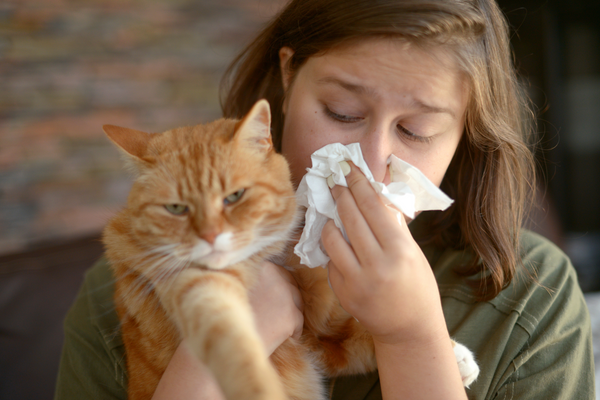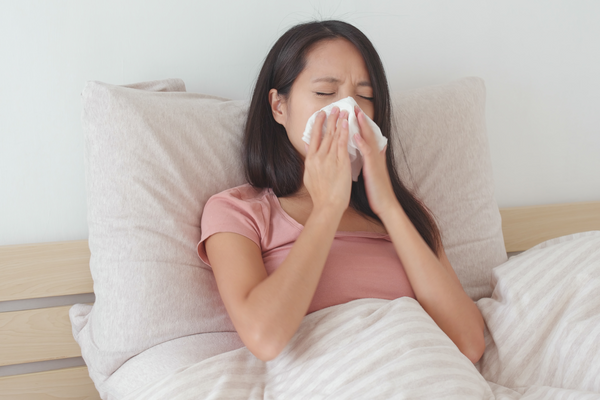Everything You Should Clean At Home After Someone Has Been Sick

If someone in your household has the sniffles, stomach bug, cold, flu, or any other other type of contagious illness, you’ll want to do everything you can to minimize the spread. By taking the right precautions – including isolating the affected individual, frequent hand washing per the recommended CDC method, and ramping up your cleaning routine, it’s quite possible to stop the illness in its tracks.
Proper cleaning is the first line of defense against contagious illness, as pathogens can live on surfaces sometimes for several days to weeks. Cold viruses, for example, have been shown to survive on indoor surfaces for around seven days. When someone in your household is sick, clean and disinfect surfaces and surroundings daily using a product, like Vital Oxide, that is clearly labeled as a disinfectant that kills 99.9% of viruses and bacteria to most effectively eradicate germs.

Vital Oxide is an EPA-registered hospital grade disinfectant that’s effective against a wide variety of pathogens, from rotavirus and norovirus, to Influenza B, E. coli, and Staphylococcus aureus. In addition, Vital Oxide has been approved by the EPA for use against SARS-CoV-2, the coronavirus that causes the disease COVID-19. Vital Oxide effectively kills all of these disease-causing germs without any harsh fumes or harmful residues. After use, Vital Oxide breaks down into simple salt and produces no harmful by-products, making it a planet-friendly choice. It’s powerful, responsible, and safe for the environment.
When someone in your home is ill, it’s good practice to wear rubber gloves (disposable ones are ideal, so you can be sure to keep gloves used for cleaning and doing dishes separate) to protect your hands from germs. And keep a plentiful stack of disposable paper towels or microfiber cloths on hand, and always toss or wash between uses so as not to transfer germs from surface to surface. Sponges should not be used for cleaning because they can harbor germs in the crevices.
Ready to give your house a deeper, more thorough clean? Here’s what you need to do to get the job done.
Materials Needed
- Vital Oxide
- Anti-Allergen Laundry Detergent
- Disposable gloves
- Paper towels
- Microfiber cloths
All High-Touch Surfaces
When someone in your household is sick, cleaning and disinfecting high-touch surfaces like doorknobs, countertops, faucet handles, tables, and light switches should be top of mind. But don’t forget to tackle other oft-touched and forgotten surfaces, like appliance handles, the microwave touch pad, stair banisters, and just about anything else that most of your family members touch on a daily, or weekly, basis.
Before you expose a surface to a disinfectant, a pre-cleaning step is always required. The process of cleaning can start to reduce germs by removing dirt, grime, and residue that can harbor bacteria and viruses, but it doesn’t reduce the germ-load to the 99.9% level. Once a surface is clean, the disinfectant will be able to do its job. The disinfectant should always come into contact with 100% of the surface, otherwise it won’t be as effective. Vital Oxide can be used to pre-clean surfaces before disinfecting under lightly soiled conditions. Clean and disinfect in two easy steps: Spray and wipe Vital Oxide to clean, then spray and leave behind to disinfect. Just make sure you are applying enough solution to remain wet for the proper contact time.
To clean heavily soiled or grimy surfaces, first use hot soapy water to wipe away grease, grime, dirt and debris, then rinse with water and wipe to dry before applying Vital Oxide to bust bacteria and virus germs. When tackling anything with crevices, like light switches, or electronics like computer keyboards, or TV remotes, first use a damp cloth to clean off dust and grime, being careful to not let any liquid seep inside, and then use a microfiber cloth dampened with Vital Oxide to swab all sides and let air dry. Never spray any kind of liquid directly onto electronics.
Cell Phone
Though all high-touch surfaces should be cleaned in the event that someone at home has been ill, it’s worth emphasizing just how important it is to disinfect the items we touch the most. This is especially true of the one item that so many of us have trouble putting down: our cell phones. It’s common knowledge that our phones are basically germ magnets - but did you know that cellphones carry 10x more bacteria than most toilet seats - and that’s in normal times, without all the extra illness-causing germs! No need to throw out your phone after you recover, a thorough cleaning and disinfecting routine can help keep illness-causing germs at bay. To clean your phone, turn it off and gently polish it with a microfiber cloth to remove any oils or crud. Next, lightly spray a clean microfiber cloth with Vital Oxide and wipe down the phone – being careful not to get any solution in nooks and crannies, including charger ports and headphone jacks – and let air dry. Don’t forget to wash your phone case! Based on the material the case is made of and manufacturer’s instructions, you should be able to wash it with soap and water. Next, spray it with Vital Oxide to germ bust.
Trash Cans
When the wastebasket is brimming with dirty tissues and other germy remnants, it becomes an absolute breeding ground for germs. Be sure to empty the contents frequently (don’t forget to wear your disposable gloves while doing so!), wash the inside of the can with warm soapy water, then rinse and dry with a paper towel. Once it’s dry, spray all sides of the can with Vital Oxide and allow it to air dry to disinfect and deodorize.
Linens & Towels
The road to recovery usually consists of plenty of rest, which results in an abundance of soft surfaces to clean. Wash contaminated bedding, pillowcases, and towels with a hypoallergenic laundry detergent in hot water, along with ½ to 1 cup Vital Oxide (depending on the side of the load) and dry as usual. Don’t forget to wash items like throw blankets, wash cloths, and dish towels that the affected person may have used. If a sick child is comforted by a stuffed animal, it should be cleaned and sanitized as well (read more on that topic here). When you’re caught up on laundry, give your washing machine a once-over so you don’t risk transferring germs to anything that’s been freshly laundered. Simply run an empty hot wash cycle through the washing machine with a dose of Vital Oxide to disinfect.
The Bathroom
This one room that needs extra attention during and after a contagious illness. Be sure to thoroughly clean the bathtub, sink, faucet handles, countertop, and toilet (handle, seat, lid, and bowl) and then spray with Vital Oxide to disinfect.
Once the sick person is feeling better, throw away their toothbrush and wash and disinfect the toothbrush holder.
The Kitchen
The kitchen is an especially important place to clean and disinfect, because it’s where meals are prepared. If possible, it’s best to keep a sick person out of the kitchen as much as possible because there are so many common items they might touch and accidentally spread germs. Even frequent hand washing might not be enough to protect others, especially from highly-contagious illnesses like norovirus.
Wash all dishes and utensils the affected person has used at high heat in a dishwasher, and frequently clean and spray hard surfaces – including countertops, tables, chairs, refrigerator handles, and drawer and cabinet hardware – with Vital Oxide.
The Car
If a person with a contagious illness has taken a ride in your car, it means that the car interior will require some cleaning to kill any germs left behind after the trip. First, pre-clean the surfaces and then disinfect by wiping the steering wheel, inside and outside door handles, dashboard controls, keys, and garage door opener with a microfiber cloth dampened with Vital Oxide. Thoroughly vacuum seats and car seats and spray with Vital Oxide to sanitize.
Want more cleaning tips? Follow The Ecology Works on Instagram @ecologyworks for lots of helpful household tips and environmental news. If you have any questions, please feel free to Contact Us or message us on Facebook. No question is too small! We’re here to help.



